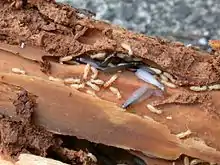Reticulitermes speratus
Reticulitermes speratus, the Japanese termite, is a species of subterranean termite found in Japan, North Korea, and South Korea. It eats decayed wood.[1][2] It is adapted to withstand the cold temperatures of the temperate regions it inhabits.[3]
| Reticulitermes speratus | |
|---|---|
 | |
| Scientific classification | |
| Domain: | Eukaryota |
| Kingdom: | Animalia |
| Phylum: | Arthropoda |
| Class: | Insecta |
| Order: | Blattodea |
| Infraorder: | Isoptera |
| Family: | Rhinotermitidae |
| Genus: | Reticulitermes |
| Species: | R. speratus |
| Binomial name | |
| Reticulitermes speratus (Kolbe, 1885) | |
The mitochondrial genome of the subspecies Reticulitermes speratus kyushuensis has been determined.[4]
Behavior
New colonies are typically founded by a male-female pair, but alternatively sometimes by a same-sex female pair, in which case reproduction is parthenogenetic.[5] New incipient colonies may also be founded by same-sex male pairs.[6] These male pairs of termites cannot reproduce, but by cooperating they are able to survive long enough that one or both has the potential to later replace a male in another colony. This male can then reproduce by mating with the female there .[6]
The queen is succeeded by asexual reproduction, in which an aged queen lays eggs with no openings for sperm to enter through, effectively making a clone of herself.[7][8] All individuals have part of their eyes developed, but the size increases if the individual is on a reproductive tract.[9]
Individuals have been shown to cannibalize injured nestmates.[10]
Queen longevity
R. speratus queens achieve a long lifespan without sacrificing fecundity. These queens have more than twice the catalase activity and seven times higher expression of the catalase gene RsCAT1 than workers, soldiers and nymphs.[11] Catalase catalyses the decomposition of hydrogen peroxide, a reactive oxygen species. Thus catalase protects against oxidative stress and oxidative DNA damage.[11] The extended longevity of R. speratus queens is likely due, in part, to efficient antioxidant capability.
References
- Choi, Kwang-Soon; Kim, Hyun Kyung; Lee, Byung-Ho; Kim, Bong-Su; Yang, Jung-Ho; Koo, Hyun-Na; Kim, Gil-Hah (April 2014). "Fumigant toxicity of phosphine to the Japanese termite, Reticulitermes speratus Kolbe (Isoptera: Rhinotermitidae)". Journal of Stored Products Research. 57: 24–29. doi:10.1016/j.jspr.2014.01.003.
- Kamaluddin, Nadia; Matsuyama, Shigeru; Nakagawa-Izumi, Akiko (2017-03-06). "Feeding Deterrence to Reticulitermes speratus (Kolbe) by Fibroporia radiculosa (Peck) Parmasto 1968". Insects. 8 (1): 29. doi:10.3390/insects8010029. ISSN 2075-4450. PMC 5371957. PMID 28272326.
- Choi, BaekYong; Itakura, Shiji; Yoshimura, Tsuyoshi (2016-09-01). "Do northern populations of Reticulitermes speratus (Kolbe) possess an additional physiological capacity to cold-acclimate that enhances cold tolerance during the winter?". Journal of Asia-Pacific Entomology. 19 (3): 643–649. doi:10.1016/j.aspen.2016.06.010. ISSN 1226-8615.
- Lee, Wonhoon; Han, Taeman; Lee, Jong-Ho; Hong, Ki-Jeong; Park, Jongsun (January 2017). "The complete mitochondrial genome of the subterranean termite, Reticulitermes speratus kyushuensis Morimoto, 1968 (Isoptera: Rhinotermitidae)". Mitochondrial DNA Part B. 2 (1): 178–179. doi:10.1080/23802359.2017.1303341. ISSN 2380-2359.
- Matsuura, K.; Nishida, T. (2018). "Comparison of colony foundation success between sexual pairs and female asexual units in the termite Reticulitermes speratus (Isoptera: Rhinotermitidae)". Population Ecology. 43 (2): 119–124. doi:10.1007/PL00012022.
- Mizumoto, N.; Yashiro, T.; Matsuura, K. (2016). "Male same-sex pairing as an adaptive strategy for future reproduction in termites". Animal Behaviour. 119: 179–187. doi:10.1016/j.anbehav.2016.07.007.
- Matsuura, K.; Vargo, E. (2018). "Queen Succession Through Asexual Reproduction in Termites". Science. 323 (5922): 1687. Bibcode:2009Sci...323.1687M. doi:10.1126/science.1169702. ISSN 0036-8075. PMID 19325106.
- Matsuura, Kenji (2002-09-01). "A Test of the Haplodiploid Analogy Hypothesis in the Termite Reticulitermes speratus (Isoptera: Rhinotermitidae)". Annals of the Entomological Society of America. 95 (5): 646–649. doi:10.1603/0013-8746(2002)095[0646:ATOTHA]2.0.CO;2.
- Maekawa, Kiyoto; Mizuno, Sayaka; Koshikawa, Shigeyuki; Miura, Toru (2008-07-25). "Compound Eye Development During Caste Differentiation in the Termite Reticulitermes speratus (Isoptera: Rhinotermitidae)". Zoological Science. 25 (7): 699–705. doi:10.2108/zsj.25.699. ISSN 0289-0003. PMID 18828656.
- Yamanaka, Y.; Iwata, R.; Kiriyama, S. (February 2019). "Cannibalism associated with artificial wounds on the bodies of Reticulitermes speratus workers and soldiers (Isoptera: Rhinotermitidae)". Insectes Sociaux. 66 (1): 107–117. doi:10.1007/s00040-018-0661-4. ISSN 0020-1812.
- Tasaki E, Kobayashi K, Matsuura K, Iuchi Y (2017). "An Efficient Antioxidant System in a Long-Lived Termite Queen". PLoS ONE. 12 (1): e0167412. doi:10.1371/journal.pone.0167412. PMC 5226355. PMID 28076409.